Angela Petch's Blog, page 10
June 26, 2019
ANGELA PETCH – THE TUSCAN SECRET @Angela_Petch @bookouture #BooksOnTour #BlogTour #Review #NetGalley #TheTuscanSecret
Today is #publication day for “The Tuscan Secret”, a revised version of “Tuscan Roots”. I came across this review just now and it really has sprinkled stardust on me. Thank you so much.
#BooksOnTour #BlogTour #Review #NetGalley #TheTuscanSecret
Release Date: 26th June 2019 / Publisher: Bookouture
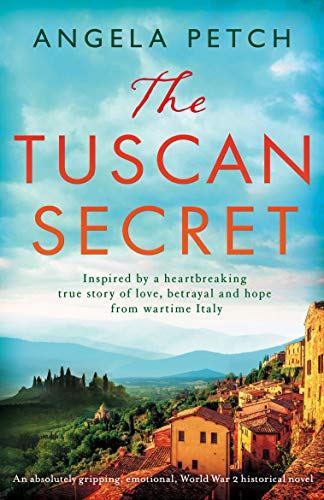
Il Mulino. An old crumbling mill, by a winding river, nestled in the Tuscan mountains. An empty home that holds memories of homemade pasta and Nonna’s stories by the fire, and later: the Nazi invasion, and a family torn apart by a heartbreaking betrayal.
Annais distraught when her beloved mother,Ines, passes away. She inherits a box of papers, handwritten in Italian and yellowed with age, and a tantalising promise that the truth about what happened during the war lies within.
The diaries lead Anna to the small village of Rofelle, where she slowly starts to heal as she explores sun-kissed olive groves, and pieces together her mother’s past: happy days spent herding sheep across Tuscan meadows cruelly interrupted when World War Two erupted and the Nazis arrived; fleeing her home to join theResistenza; and…
View original post 510 more words
June 8, 2019
Write Away in Tuscany 2019
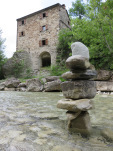



Once upon a time there was an old watermill along the river Marecchia in Eastern Tuscany, lost in the Apennines. It had perched on its rock for centuries in countryside where wild boar and deer still graze and where orchids and wildflowers grow in abundance.
Some people say this watermill dates as far back as the 13th century. The story goes that, way back, the owners sold it to the little town of Badia Tedalda further up the mountain. Then they changed their minds and a skirmish ensued, where four people were killed by soldiers sent by the disgruntled purchasers.
Mills were vitally important for survival. This particular mill ground wheat, barley, rye and corn for local people who brought their grains to the mill and tethered their donkeys to metal rings secured to the wall.
At the very end of the twentieth century, a couple from England fell under its spell. It had stopped working twenty years previously. Inside were mouse-nibbled mattresses, windows without glass, a roof that needed replacing, disused hoppers and millstones and dozens of horseshoes. It needed a lot of work, but we scraped together our savings and bought it.
Twenty years later, we are still in love with this inspiring place, set in a magical location and we let it out to holidaymakers from all over the world. It is such an important place for us. In this beautiful, unspoiled corner of Tuscany, we find time to take stock. It has inspired me to write and it has helped us both with our general well-being.
Last year we held a writing week and this year, from September 11th to 18th, we are doing it again.
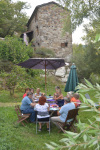
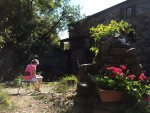
The group is small, never more than ten. Last year, there were complete beginners and published authors. Here are some of the reviews:
REVIEWS from 2018
• “The course offered me true escapism through my own spontaneous writing and also that of others. I have made new friends and spent lovely times with old friends. I leave [Tuscany] feeling refreshed, totally inspired to write and just a little bit ‘proud of myself’.” (Novice writer and winner of Flash Fiction 2018).
• “Food was lovely. Excellent cooking and supply. Plenty of wine.”
• “Perfect! … Beds and rooms wonderfully comfortable.”
• “Excellent value! Been like living in a film set. Such welcoming hosts and wonderful atmosphere you couldn’t buy.”
• “Excellent value”.
• “I enjoyed the challenge and the discipline of the course. The accommodation was extremely comfortable. You had thought of everything we could possible want and added a few touches of your own.”
• “The meals were wonderful. In some ways the meals we had at Il Mulino were better than the restaurant meals because more informal and relaxed.”
• “One word – FAB – U – LOUS.”
In 2018 we had Sonja Price to tutor us and she was really helpful, but this year we are aiming the week at writers who have works in progress, for those who want to start to write and who need peace, tranquillity and space to write, write, write, without interruption. No cooking, no housework, just time to write and dive into the imagination.

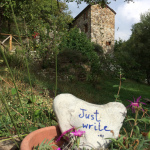
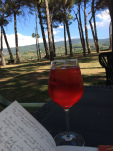
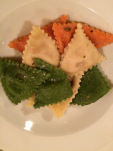
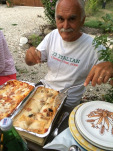
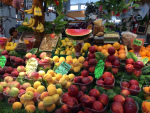

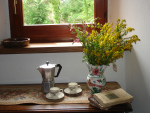
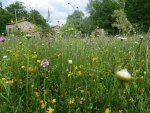

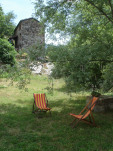
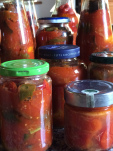
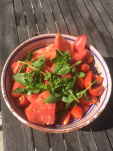
If you want to join in, there will be discussions on all things writerly too: writer’s block, research, speech and dialogue and brainstorming beginnings, middles and ends for your story are some of the subjects. These sessions are all optional. Each morning will start with a five-minute limbering-up writing exercise to kick-start your creative juices.
On Friday 13th, One Stop’s Fiction Kathryn Bax and her son, Kent, will lead a day’s session on “Self-publishing tips for success.” We are really excited about this. Some local writer are dipping in for this.
If you are artistic and would like to have a break from writing, on Monday 16th September, a local artist, Joy Boncompagni Stafford will hold a morning session on watercolour. (This is an extra and will cost Euros 25, materials provided).

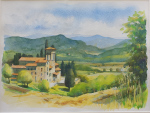
A couple of Joy’s paintings
Last year’s Flash Fiction Competition was very popular, and we shall run this again. Title to be announced on the first day of the course.
Participants are invited to send in one piece of work (wordcount 2,000 max) no later than three weeks in advance of the start of the course, to share and receive constructive feedback.
During the week there will be an opportunity to visit the enchanting towns of Sansepolcro and Anghiari, to include an (optional) writing exercise.
So, what does all this cost, I hear you ask?
This year we have reduced the price to £550.
This includes accommodation in our restored watermill. There is one double room, with en suite still available in the mill.
[image error]
If you want to see more photos of the inside of our restored watermill, we have our own site: Il Mulino, Rofelle
And, within walking distance, there is a beautifully appointed guest house, or agriturismo for extra guests. All rooms have en suite. Il Casalone
Our price includes food, drinks and wine, except when we eat out at a local restaurant or pizzeria on two occasions during the week.
It includes airport transfer to and from Bologna airport, as long as you arrive before lunchtime on September 11th. If you plan to arrive at a different airport, you will need to sort your own transport. We can advise on this.
It does not include your flight or the couple of meals, snacks or drinks when we go out twice during the week. If you prefer to stay at the mill to write instead, we can leave you food to self-cater.
If you are interested in one of our remaining spaces, or have any other queries, please contact me in the comment box below, on private message on Facebook or Twitter or via this email address: petchangela@gmail.com
Twitter: @Angela_Petch
June 3, 2019
Ne’er cast a clout till May is out…
That old saying has been so true. I was glad of my thick Aran sweater over the last weeks here in Tuscany. I guessed June would come in like a bride and she has. The clouds are now billowing like a puffy dress against a blue sky and the orchids and wildflowers are finally pushing their way up through the tufty grass. I was a little lazy and asked my orchid experts on Twitter to identify a few, despite my fuzzy photos.
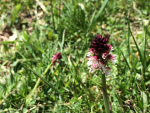
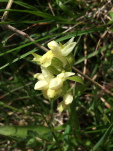
Check out Jon Dunn’s beautiful book Orchid Summer
Thanks, Jon! I need a better camera, but he came up with Burnt Orchid for the photo on the left and Provence Orchid for the pale flower.
[image error]
I spotted these on a walk high up to 1,407 metres in the Apennines with my brother and sister-in-law, who chose the worst week, weather-wise, to visit. But this didn’t stop us from enjoying a couple of outings. Always keen to research stories, we drove to an area that saw fierce fighting during WW2: the Coriano and Gemmano ridges. From 4th to 15th September 1944, the British 8th Army made assaults here along the eastern edge of the Gothic Line. I could tell Maurice was particularly moved, as his own father might well have been involved. But that generation seldom shared these facts with their children. At Montegridolfo, there is a small museum with a big heart, run by volunteers and it was humbling to read details of this period. We read dozens of various propaganda posters printed by all sides and looked at items found scattered around the countryside. The elderly man who showed us round was only six years-old when it all took off and he shared a couple of personal incidents. It’s easy to overlook the civilians’ viewpoint and I’m pleased that authors can bring ordinary stories into the open.
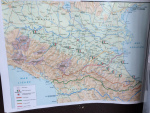
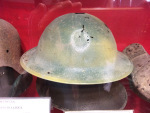
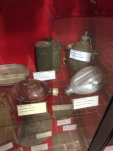
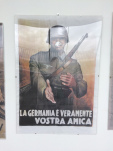
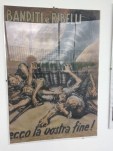

Afterwards, we visited the Commonwealth War Cemetery a few kilometres away. This grave touched me. I wondered who had recently left this photograph next to their Canadian soldier.
One week earlier I had visited a delightful gentleman of ninety-nine. Bruno was a POW from very early on in WW2, captured in Egypt and then transported to Nottingham, where he worked on the land. He was born in Montebotolino, the tiny hamlet within walking distance (admittedly a good workout) of where I am writing now, and one of my favourite haunts, as you might know. Bruno is very frail now and I first met him nearly ten years ago when I was on another walk. I came across him pruning his apple trees and after a few minutes of general chitchat, he started to talk to me in English. And then, out came his story. A fascinating account which I am shamelessly using (tweaked and slightly fictionalised) in my next Tuscan novel. He is frail now, but he still has a twinkle in his eye. He told me he liked rice pudding during the war in England and he is looking forward to the party the local Comune will lay on for him when he turns one hundred in January. I don’t think he will mind appearing in my book and I also believe we need to never forget the part ordinary folk played in shaping our futures.
[image error]
Now, back to writing. I’m over three quarters through the first draft but that is only the beginning. Rigorous editing will follow. Ciao for now!
May 18, 2019
Returning to Italy…
“Ciao”, or “salve”, as the expression goes nowadays.
It is really cold here in Tuscany at the moment. As I write, I am wearing two jumpers – one of them a thick Aran faithful, plus my cosy socks. Not many people understand why we live here in the summer and Sussex in winter. But, we’re high in the Tuscan Apennines, the winters are bighting-cold and summer rolls up when it wants. It’s arriving late this year, like a bride. When it decides to come, it will be glorious.[image error]
Here I am, wearing my warm Aran. Snow fell on the Mountain of the Moon last night.
We are being warned that our planet is in danger. The world is topsy-turvy and our way of life is having dire effects on climate change, amongst other problems. At the moment, the radio tells me it is over 20 degrees in Scotland. Here it is 6! [image error]
I know that before too long, the bees will be buzzing over my lavender and our meadow will brim with butterflies and orchids, but in the meantime, I need to warm up by chatting to somebody else who loves Italy. Welcome back, Daisy James, who has recently published another of her Limoncello novels. As you know, I am passionate about Italy and, even though I haven’t read Daisy’s book yet, I wanted to find out about her writing career and what she thought of la bella Italia. I’m saving the read until I can laze by the river when the sun arrives.


Daisy, what makes you want to write about Italy? Have you visited?
Italy is one of my favourite places to visit. We were lucky enough to take a trip to Florence last summer where we explored the city, all the wonderful little nooks and crannies, and ate some wonderful food too – the gelato is to die for! My favourite was saffron flavoured, I didn’t fancy the marmite and walnut flavour for some reason! Whilst we were there, a Hollywood movie was being filmed around the streets and famous monuments which was fun to watch. It was really strange seeing movie directors hanging from helicopters over Il Duomo![image error]
Florence has a special place in my heart too, Daisy. But, I never came across Marmite gelato in the 70s. Yuck! I spent a year there as part of my university degree, when I was twenty. In fact, I fell in love with a handsome Florentine who drove me all over Tuscany in his Alfa Romeo Spyder. I lived in a tiny flat with a view over the terracotta tiles, near the station. Not a particularly desirable area at that time, (a bit of a red-light district, if I’m honest), but I learnt lots of Italian! Later, I realised I hadn’t been in love with my handsome boy – I’d been in love with Italy and that continues.
My next question concerns your writing. I have lots of indie author friends and they are always interested in how people come to be published. How did you get with Canelo?
I’m really fortunate to have my novels published by the people at Canelo. Everyone there is incredibly supportive, friendly and approachable. I saw a call-out for submissions a couple of years ago and thought I’d nothing to lose so I sent of my manuscript for The Paradise Cookery School – set in the gorgeous Caribbean – which is the first of the books I had published with them. I was fortunate enough to have it accepted by my wonderful editor there, Louise Cullen, and I have a new series this year – Villa Limoncello which is set in Tuscany – the second of which is due out in June.
What other books have you written and how did you come to writing?
Apart from my two series with Canelo, I have standalone novels published by HQStories who were my very first publishers. I’ve been writing since I could hold a pen, sketching pictures to go with my stories and then binding the paper with string to make them look like books! I wrote throughout my teenage years, but stopped whilst I was at university, then started again when I had my family – just short stories at first. I wrote my first full-length novel in 2012 and it’s still in a shoe box on top of my wardrobe where it’s definitely going to stay! My next was The Runaway Bridesmaid which was my first published novel, set in New York and Devon.
I wonder if you will ever develop that story stashed in the shoe box! Maybe modify it, use some passages for another book? They say you should never throw anything away!
For anybody who has never visited Italy before, where would you recommend?
Gosh, that’s a really difficult question! There are so many wonderful places – Florence, Siena, Pisa, San Gimignano are all amazing places to spend time and I thoroughly enjoyed our trip there last year. I also love the south of Italy too – I had a fabulous break in Sorrento a while ago, and especially enjoyed the boat trip over to Capri – the views were stunning! However, top of my list for a first timer would have to be Venice. My tip would be to catch the train and arrive at the station, then to simply wander around the streets and soak up the atmosphere rather than rushing from one tourist attraction to the next. I went when I was a student, so we couldn’t afford to visit these places, but I think I found more of the real Venice this way. I’d love to go back!
I need to return too. The last time I visited Venice was when I was eleven. But, we are very busy in our six months here with our holiday guests in our converted watermill. This September, we are running a Writing Week for the second time, so time slips away in a flash. The best thing to do would be to mark free weeks at the beginning of the season on our calendar and then take off to explore. Last year, we visited the Abruzzo region. Wild and beautiful too, but afflicted by earthquakes, unfortunately.
Daisy, what are your three top writing tips?
Read, read, read.
Write, write, write.
Never give up – rejections, although difficult, are part of the journey.
I agree with you. Plus, when you’re writing, try not to edit as you go along. There’s a danger of blocking yourself. Chop, change and restructure afterwards. For me, it’s probably the hardest part of writing. But, so important.
Do you have a picture of where you write?
When it’s warm – I love to write in my little summerhouse (aka: shed!)
[image error]
That is so cute! I’m trying to imagine what it’s like inside… tidy? No internet for distraction? A kettle and mug for tea or coffee? A bottle and opener for celebrating when the writing flows? A comfy chair for sitting in when reading over what you’ve created? Or is it untidy and that’s why you don’t want to show us?
It’s been great fun chatting. I could do with a glass of Limoncello right now… in fact, I think I’ll have one by my side when I manage to find time to read your book. Before you go, tell us something we would never guess about you!
When I’m not writing, I like nothing better than to spend time on the archery field!
That’s original. Hope to catch up with you soon! A presto and thank you. Mille grazie! Good luck with your books.
Here are a few more facts about Daisy and you can click on the links below to see her book.
Daisy James is a Yorkshire girl transplanted to the north east of England. She loves writing stories with strong heroines and swift-flowing plotlines. When not scribbling away in her peppermint-and-green summerhouse (garden shed), she spends her time sifting flour and sprinkling sugar and edible glitter. She loves gossiping with friends over a glass of something pink and fizzy or indulging in a spot of afternoon tea – china plates and tea cups are a must!
Summer dreams at Villa Limoncello
Escape to Villa Limoncello… where dreams come true in the most unexpected ways.
Izzie Jenkins never expected to find herself living in a gorgeous oasis in Tuscany but when life gives you Villa Limoncello you say thank you and bake treats to celebrate!
Izzie and debonair chef Luca Castelotti are officially setting up shop together but when their inaugural ‘Pasta and Painting’ venture is sabotaged and one of their guests poisoned they’re forced to turn detective. Because if they can’t find the culprit, they’ll be out of business before they’ve even begun…
A gorgeous holiday read.
May 4, 2019
A change
They say a change is as good as a rest. It’s hard work packing up to leave the country for six months. And to drive one thousand miles from West Sussex to Tuscany. But we enjoy it, despite the laden car packed to the gunnels, as if we are leaving forever.[image error]
Taking coals to Newcastle???
We took an extra day this year and stayed near Colmar in Alsace. Our chambre, overlooking the snow-capped range of the Vosges Ballons, was in the home of Luc and Marie-Helene. We managed a friendly hour or two with them, conversing in our school French. What a lovely couple. They gave us a couple more tomato plants to add to those Maurice had packed. (He grows his from seeds he collects from his Italian tomatoes and starts them off on our kitchen window ledge in England). I don’t like to get political on social media, but I do believe that if there were more inter-cultural exchanges like our mini-break, there would be fewer wars and certain attitudes over the B word (notice I don’t actually spell it out), would be modified. (I fully realise I am simplifying matters, but maybe we need to sometimes. Our country is in a dreadful tangle at present.) Entente cordiale springs to mind, as a solution.
That apart, we wandered around the quaint town of Colmar, admiring the colours of the wooden buildings that look like gingerbread houses and trying local wine and cheeses. Having a day off in the middle of our journey helps breaks up the driving.
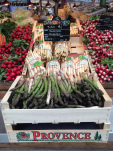
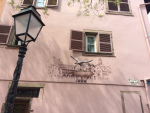
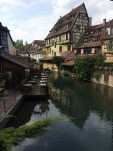
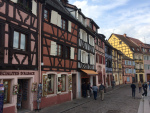
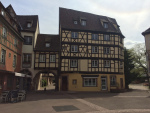
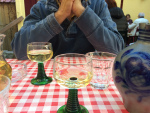
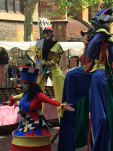
However, this year I have final edits to do by May 8th for “The Tuscan Secret”, which comes out mid-June. So, I couldn’t relax completely. I feel as if I know the book off by heart now, having gone through structural, line, copy and finally, proof edits so many times. It’s amazing where you can work, when needs must.
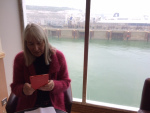
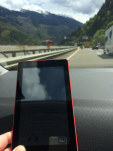
On the channel ferry and on the Swiss roads
I can’t wait to get back into writing the sequel, but if it all goes pear-shaped and the books don’t sell, I shall continue to write my short stories. As if to console me, after hearing the news from my editor at Bookouture that they need to tweak my book description, because the pre-orders are not amazing, I received an e mail as we drove through Switzerland from my other editor at the People’s Friend. The magazine has bought two more of my stories and also want to feature me on Author of the Week in the May 18th issue. If I could have leapt about with joy, I would have, but I was firmly strapped into my car seat as we drove through the Swiss valleys. Perhaps I should have tried yodelling instead. (Perhaps not).
We have a lot to do before our first guests arrive at the end of the month to stay in our converted watermill. The place needs spring cleaning plus a lick of fresh paint and the garden needs pruning and taming. Just as with my edits, I have more cutting back to do, and plants need moving to different beds. All very reminiscent of the structural edits I have had to do, moving chapters around and deleting passages superfluous to the plot. Wish me luck, please.
[image error]
April 27, 2019
Daisy, Daisy, give me your cover do!
I’ve just met another Italophile via social media and this post is an antipasto for a future Italian feast with Daisy James.
For the time being, just let me tell you that her new cover was revealed yesterday and I’m allowed to share it with you. I haven’t read the book yet, but it’s teetering on the top of my to-be-read pile. The cover is so happy and mouth watering (like lots of Italian experiences).
[image error]
And here is the blurb:
Escape to Villa Limoncello… where dreams come true in the most
unexpected ways.
Izzie Jenkins never expected to find herself living in a gorgeous
oasis in Tuscany but when life gives you Villa Limoncello you say
thank you and bake treats to celebrate!
Izzie and debonair chef Luca Castelotti are officially setting up shop
together but when their inaugural ‘Pasta and Painting’ venture is
sabotaged and one of their guests poisoned they’re forced to turn
detective. Because if they can’t find the culprit, they’ll be out of
business before they’ve even begun…
A gorgeous holiday read perfect for fans of Sarah Morgan and Jenny
Oliver.
*
You’ll have to wait for the main course once Daisy and I have shared a glass or two of Prosecco (and Limoncello) and I’ve chatted to her about why she too is in love with la bella Italia!
[image error]
A presto!
April 25, 2019
Chatting with Carol Thomas again…
[image error]
It’s so good to be sitting with Carol again in the holiday sunshine and talking about writing. She’s released another book recently and I love the catchy title.
First of all, tell us a little about “Maybe Baby”.[image error]
Maybe Baby is a romantic comedy and the sequel to The Purrfect Pet Sitter (Lisa Blake book #1). While each book can be read as a standalone story, Maybe Baby revisits the characters from The Purrfect Pet Sitter as they move into the next phase of their lives.
Book blogger, Rachel Gilbey delighted me with her review that said: “Incredibly entertaining, this book has everything, animals, humour, romance, an old flame and a pregnancy test! … The pages just flew. The writing flowed well, and I really enjoyed all the characters, both human and furry!”
I can vouch for it being standalone. I haven’t read its prequel yet, but it didn’t matter. The characters and story of this sequel drew me in immediately.
Your stories are contemporary. I’m used to researching history for my Tuscan novels and delving into archives. How do you go about your research, Carol? I know your Facebook followers are really useful to you in this. You enjoy getting them involved, don’t you?
I do, indeed, and their help has been invaluable in the creation of Maybe Baby. As it states in Rachel’s review, the book involves a pregnancy test; despite the fact I have had five pregnancies, and I am a mum of four, I felt it was important to speak to other women about their pregnancy experiences.
I put a request on my page asking for new mums to answer a few questions, and the number of responses I received was overwhelming. They came through the night (these ladies insisted they were up anyway) and into the next few days.
[image error]
(Carol and her own babies)
The generosity of those who took part was amazing. They shared intimate details about their pregnancy and birth experiences. I smiled, cried, cringed for them, and laughed out loud as I read. I had, of course, asked for the humorous and embarrassing bits as well as the sensible and more serious aspects 
April 14, 2019
My Top Twelve Tips for Healing Insomnia
I think we all suffer from insomnia at some tine or other. I found this blog really useful. Thank you Brigid Gallagher. xx
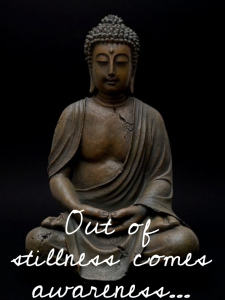
Does fibromyalgia cause insomnia or does insomnia cause fibromyalgia? I do not have a definitive answer. However, I do know that insomnia can wreak havoc on health and well being.
I first succumbed to fibromyalgia in 2003, and insomnia took hold of my life for seven long years.
15 years later, my lifestyle has completely changed and I have embarked on a new life path, embracing a slower pace of life, as per the title of my memoir.
My top tips for healing insomnia are:
Limit sugar, caffeine and alcohol
Sugar and caffeine are both stimulants. Eating sugar causes a spike in blood glucose levels, causing an immediate stimulation of the brain.
Caffeine acts on the central nervous system to increase alertness and attention. It can stay in your system for up to 12 hours – not so good if you are prone to insomnia!
Alcohol may help you fall asleep more quickly…
View original post 802 more words
March 31, 2019
Chopping, changing and other challenges…
[image error]
On Friday, to my delight, the new cover for my first Tuscan novel was released by Bookouture. As hackneyed as it sounds, this is a dream come true for me because I have a two-book contract with this amazing publishing company and the whole process has been a revelation.
To get to this point has been like taking a large piece of material and then measuring, cutting, fitting it over and over again until I produced a garment that looked good. But, instead of my standing in front of a mirror, asking myself if the sleeve was right, or the hem lopsided, whether the colour suited or the style was up to date, I had close guidance from a lovely editor. Ellen Gleeson has helped me through structural and line edits. An external copy editor has gone rigorously through the book and after the final proof read, publication has been set for June 26th. The book is now on pre-order for 99 pence.
I chatted to Ellen in between all this and enjoyed the informality (and it gave me a break from editing!)
[image error]
Ellen, how did you get into the job of editing?
My first job in publishing was a work experience placement in the audio department of HarperCollins. I then worked as an Editorial Assistant at Collins Learning, working on primary and secondary school material teaching materials, but I always knew I wanted to move to fiction: bringing the kind of books I love to read to as wide an audience as possible. After a couple of years away from publishing I joined Bookouture as a Publishing Assistant, and have since been promoted to Publishing Executive, which involves looking after my own authors. I love it!
With all the scrutiny you have to bring to books in your work, are you able to read now purely for entertainment, without mentally editing?
Yes! Of course every reader thinks critically about what they’re reading, it’s part of the process and part of the enjoyment. But I love reading as much as I always have.
What kind of books do you enjoy?
I love fantasy novels for the pure escapism and wildly imaginative worlds you can find yourself in. Epic historical stories, for seeing characters flung into situations you’d never be in, and the things you find out about the past and other places. Police procedural crime for pure grip factor. One of my favourite books of last year was The Seven Deaths of Evelyn Hardcastle which combines a classic murder mystery story with an amazingly inventive high-concept twist.
What advice do you have for a new author thinking of writing a book? How do you think he/she should start?
Get going! Have a plan for your story structure, and write, write, write. Writers’ groups on Twitter are a great place to turn if you’re feeling alone or demotivated. Taking part in something like #NaNoWriMo can really spur you on and get those words on the page. Also, know what genre you’re writing in, and read successful books in that genre to get a sense of what’s working.
Do you have any hobbies?
I’m a member of SHE choir: a relaxed, collaborative choir for anyone who identifies as a woman. All the songs we do are arranged by members so anything goes: pop, R&B, folk… I absolutely love singing with this incredible bunch of women.
Tell us something we wouldn’t guess about you.
I once drunkenly got my eyebrow pierced on holiday. It looked awful, and when I got back my friends laughed at me so much that I took it out.
If you could invite three authors to an informal supper in your kitchen, who would they be?
Marian Keyes, for a good laugh round the table and hopefully some wise words about family and relationships. If I can bring him back, Terry Pratchett, an author I’ve loved since I was ten. His witty and whacky observations about the world would make for great conversation, by all accounts he was a wonderfully kind man and I would love to pick his brain about the Discworld. And you’ve got to be on the list Angela – despite working closely together for months, we’ve never properly met and that has to be remedied. And you can bring some delicious Italian food with you.
Aw, how lovely! You’re on, Ellen! I feel so lucky to be working with you. Your support is invaluable. I’ll start thinking up a menu!
Another very supportive, encouraging editor I have met on-line is Alan Spink from “The People’s Friend” women’s magazine. Over the last two years I have had a dozen or so short stories accepted. I know that’s not very many by other writers’ standards, but I’ve been submitting for many years without success. So I am delighted for the progress I’ve made so far.
[image error]
Writing short stories is obviously different from writing a novel, but the editing is equally as important. I enjoy the discipline and the challenge. Alan always points out ways I might improve a story that he can’t immediately accept and his advice is very welcome.
I chatted to Alan via the weekly writing hour that the magazine has each Tuesday morning at 11 o’clock. (Could all this chit-chat be defined as displacement activity? I don’t think so… it is so useful to have in my mind that there are real people in the industry; that we are not simply submitting our work to an impersonal address where mountains of slush piles teeter and fester, never to be read.)
On this regular forum we were asked, if we had the chance, whom would we like to interview on the magazine, and I suggested Alan. Lo and behold, he replied. Here are his answers to yours truly:
“In Fiction Tracey’s recent Writing Hour on Twitter, she was posed some questions for my good self. Never one to shirk a challenge, I said I’d be delighted to answer them. So lo and behold here are the Q&As, which I hope you’ll find fun and interesting.
How did you start working for “The People’s Friend”?
I have worked for DCT since 2004, having had no previous editorial experience. I first started working for our sister magazine, “My Weekly”, and I remember the Fiction Editor at the time, Liz Smith, saying my chatty covering letter helped me get the job.
After two years, the “Friend” beckoned, the magazine I am happy and proud to call home. To those who are applying, or thinking of applying, for future jobs – if you can bring your personality to the fore through a letter or interview, then like me, it might make all the difference in landing you that dream job.
Are you a writer yourself?
I love to write but, sadly, I don’t seem to find the time these days. I have written a few short stories for the magazine and, like most writers, I dream of writing “that” novel one day. To me, there is nothing better than locking the world outside and transporting yourself into a story world, letting characters express themselves through your imagination.
I so agree with that, Alan. We can do anything in this world that we create. Power!What are your favourite books?
Like my taste in music, my book reading is eclectic. I tend to favour historical novels for my fiction reading, and my non-fiction reading comprises of biographies and autobiographies. I’m also a bit of a stats fan, so almanacs of various description line my book shelf at home. My favourite classic novel would have to be “The Strange Case Of Doctor Jekyll And Mr Hyde” by Robert Louis Stevenson. I read that as a teenager and was instantly captivated by RLS’s gothic storytelling. More up to date, Markus Zusak’s “The Book Thief” is worthy of a page-turning mention.
And, thinking of the magazine, what is your favourite type of short story, and your least liked?
My favourite type of short story would have to be historical again. I think the imagination can accept elements of improbability with historical fiction. In some ways, the imagination demands it. It’s campfire storytelling, where heroes and heroines are brought alive through a world of timeworn mystique and endless possibilities. I’m not a fan of the crime genre. It seems to be all the rage, but that can often equate to stereotypical writing.
Describe working in a predominantly female squad?
Ha ha. No one day is the same. Will you settle for that? Seriously, though, it’s great. There are three guys who work in the “Friend”, and I think we’d all agree that we feel as part of our individual teams as we do the magazine. It’s true, sometimes the fiction ladies talk about fashion or favourite male celebs they have a crush on, but I do the guy-old thing of zoning out. Works like a charm!
Out of interest, what is the percentage of male to female PF writers?
Oh, that’s a good question. I’d say it’s about 5% of men who write fiction for us, regular and unsolicited manuscript writers included.
And, finally, can you give us your best tips for submissions?
There are three. One – read the magazine. Not just a single issue, but read it regularly so that you get a feel for the fiction that we publish. Secondly – don’t give up. I know of two writers of mine who spring to mind here, and both had multiple stories (easily double figures) rejected before they received their first story success. And one success was quickly followed by a second, and then a third . . . Three – stay true to your own storytelling voice. We are all unique, so let your personality shine through your writing.
Thank you, Angela Petch, for the questions.
You are more than welcome, Alan. It was fun and I am very grateful for your time.
Alan Spink
Alan is a member of the “Friend” Fiction Team. He enjoys working closely with writers and being part of the creative process which sees storytelling ideas come to fruition. A keen reader, he also writes fiction and enjoys watching football and movies in his spare time. His one aspiring tip to new writers is to “write from your imagination”.
If you would like to read the original interview and maybe read the regular newsletter from this long-standing magazine, then click here
I’ve enjoyed chatting with my editors and I hope you might derive some useful tips from the interviews.
Now, on with the editing!
March 1, 2019
Digging up history
Meet John Broughton, an author from Lincolnshire who came to Italy for a year in 1986, met Maria, and stayed ever since. I had an appointment with my friend in a little bar near Pompei, about half way between our Italian homes. We sipped our glasses of “Villa dei Misteri”, a prestigious wine made by Mastrobernardini, who obtained permission to use the historic Pompei vineyards and research Roman techniques. (Each bottle cost €100 and so I’ll leave it to your imagination to decide if I’m using artistic license here about the truth of what we were really drinking …)

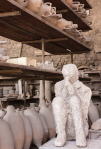
In AD 79 the secrets of Pompei were burned in an avalanche of boiling mud and ash from Vesuvius, so Pompei seemed a fitting venue to chat about the adventure of writing. Both of us write historical novels and try to excavate hidden stories and secrets with our research. John’s books feature the Dark Ages. I enjoyed his first book, The Purple Thread and am proud to have my quote on his cover. Discovering the world he describes, set in the era after the Romans have left Britain and the Christian Church is becoming the dominant force in the western world was “like being led by eerie candlelight into another world.”
I have all his other books waiting on my Kindle and I know I won’t be disappointed. I learned such a lot about this early period of history from John’s work and wish I’d had an entertaining teacher like him at school.
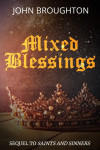
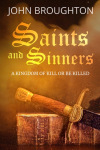
I asked John why he enjoys writing in this period.
Saints and Sinners and Mixed Blessings, its sequel (Nov 2018 and January 2019) are set in my favourite period – the Anglo-Saxon era. I like it because my surname is Anglo-Saxon – a place name that means a fortified hill by a stream. Saints and Sinners began with my desire to write something set in my home county of Lincolnshire but the Dark ages are very dark for the Kingdom of Lindsey. Even so, I wrote about St Guthlac, who was a hermit in Crowland in the Fens. He went from being a violent, heavy-drinking, womanising nobleman to being a saint. Typical Lincolnshire lad but in reverse! His best mate Aethelbard went from being an outlaw to becoming one of the greatest kings of Mercia. The book is about them.
The Purple Thread was an education to me, as well as being a fabulously entertaining read, full of description and great characters. I felt immersed in that world. How much research do for your books?
I admit to doing a lot of research, filling whole exercise books. But I enjoy it nearly as much as the writing. Of course, in the genre of historical novels you can only use a small fraction of what you discover, to avoid creating ‘knowledge dumps’ in the middle of your chapter. I try to pick out juicy snippets – either events like the racial massacre of Danes in Oxford or how the Saxons dyed cloth yellow or how the Danes built a long ship (just some interesting bits). After all, who wants to read a historical novel without a feel of the period?
Absolutely agree! I need to visit the places I write about. It’s not enough for me to look them up on Google. I need to be able to breathe, to listen and to see the locations to make them come alive. In that way, you can pick up details you might not have thought of, merely sitting at a desk. I take notebooks with me wherever I go. Where do you write?
I write in a corner of our sitting room where I have a desk next to a bookcase. I do all my writing on the keyboard in Word for Mac. Unfortunately for me, we live next door to a noisy bar, so I claim to be the only writer in the world who can blot out boozy, swearing football fans! Iron concentration, that’s mine! And yes, I would love to write by a quiet gurgling stream in Tuscany. Do I have a routine? Yes, more or less. It’s just that some days you think you’re going to write thousands of words but end up with nothing and other days you don’t feel like it but do your best work- I can’t explain that. But anyway, usually, after breakfast I deal with my e-mails. That done, I re-read the last few paragraphs I wrote the day before and write until about 11.30, by then I’m desperate for a walk. My best work tends to happen between 16.00 and 18.30 and then, not being able to beat them at the bar, I join them!
I hope you don’t drink from €100 bottles all the time, as we are doing today! And, when you’re not writing, what do you like to read?
I enjoy – surprise! – historical novels, but lately I’ve read rather a lot of World War 2 novels. Perhaps I’m trying to make up for the fact that my dad didn’t like to talk about the war, probably because he was in the RAMC and he was the only survivor of a ‘friendly fire’ episode. His best mates died.
Yes, traumatic times and that generation didn’t talk much about the war, did they? I found that with my own parents. Thank heavens for diaries.
Have you ever self-published?
I have a little experience of self-publishing but that showed me how difficult it is to promote your work, especially if, like me, you live in Italy all year round and can’t rely on support groups or go to libraries or schools to promote your work. I have a very friendly editor, James, at Endeavour Media – I say that because he has yet to reject one of my submissions! I prefer to have my work promoted by a publisher, even if a lot of what they do is unseen by me so it’s a question of trust.
Yes, all the social media input involved with publicity can distract from writing. But it has it plus sides! I’ve made lots of new friends as a result, including yourself. It’s been great to talk. Cheers, cin cin and good luck with your writing, John. By the way, if you come my way to Tuscany, it’ll be Chianti or Montalcino… sfuso (from the barrel).
[image error]
About the author
I was born in Cleethorpes Lincolnshire UK in 1948: just one of the post-war baby-boom. After attending grammar school and studying to the sound of Bob Dylan I went to Nottingham University and studied Medieval and Modern History (Archaeology subsidiary). The subsidiary course led to one of my greatest academic achievements: tipping the soil content of a wheelbarrow from the summit of a spoil heap on an old lady hobbling past our dig. Well, I have actually done many different jobs while living in Radcliffe-on-Trent, Leamington, Glossop, the Scilly Isles, Puglia and Calabria. They include teaching English and History, managing a Day Care Centre, being a Director of a Trade Institute and teaching university students English. I even tried being a fisherman and a flower picker when I was on St. Agnes, Scilly. I have lived in Calabria since 1992 where I settled into a long-term job, for once, at the University of Calabria teaching English. No doubt my lovely Calabrian wife Maria stopped me being restless. My two kids are grown up now, but I wrote books for them when they were little. Hamish Hamilton and then Thomas Nelson published 6 of these in England in the 1980s. They are now out of print. I’m a granddad now and happily his parents wisely named my grandson Dylan. I decided to take up writing again late in my career. You know when you are teaching and working as a translator you don’t really have time for writing.
As soon as I stopped the translation work, I resumed writing in 2014. The fruit of that decision is my first two historical novels, The Purple Thread and Wyrd of the Wolf, published by Endeavour Press, London. Both are set in my favourite Anglo-Saxon period and are available on Amazon as eBooks and paperbacks. Currently my third and fourth novels are available from on Amazon, Saints and Sinnersand its sequel Mixed Blessings set in on the cusp of the eighth century in Mercia and Lindsey. A fifth Sward and Sword will be published in June 2019 About the great Earl Godwine. I have two more under consideration and three others just lurking in my computer.





